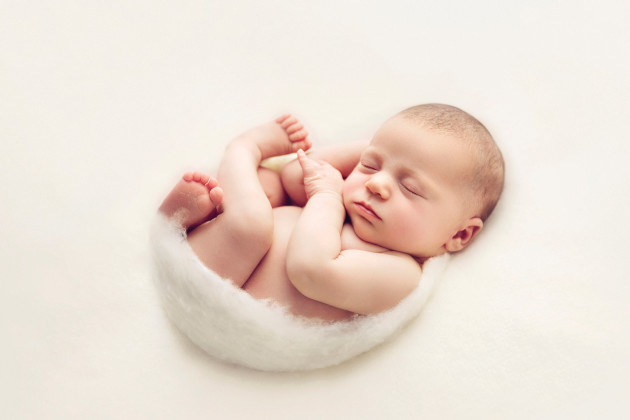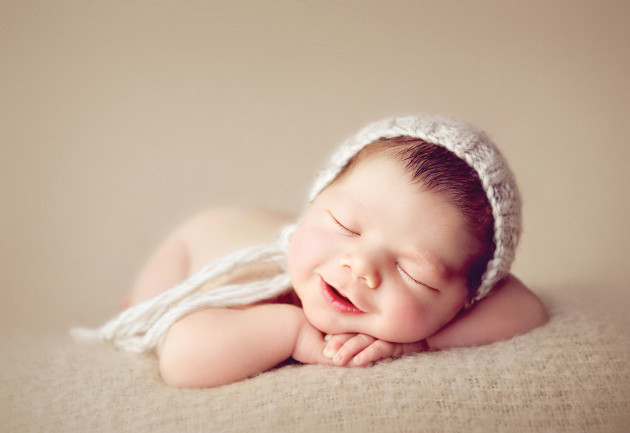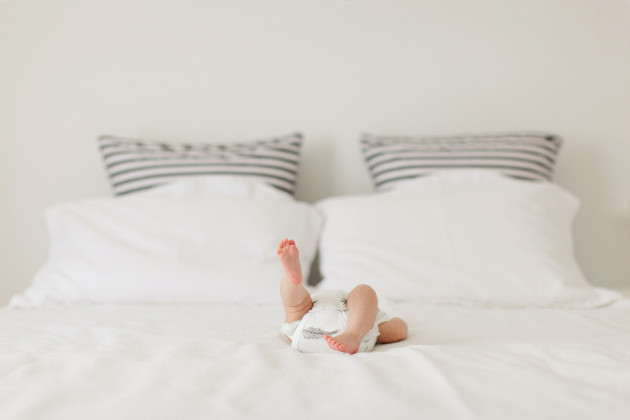Secrets of Newborn Photography

Capturing the grace of newborns in their first few weeks of life is as demanding and specialised as any other professional photography niche. Nikki McLennan examines the crucial technical, business and safety aspects, and speaks with pro photographers to get their advice on mastering the art of newborn photography, and how never to get rattled.
Client relations and expectations
When you’re dealing with emotionally vulnerable parents whose newborn has only been held by hospital staff and immediate family, patience and sensitivity are imperative. Kelly Brown, 2014 AIPP Australian Family Photographer of the Year, 2014 AIPP EPSON Queensland Professional Photographer of the Year and owner of Little Pieces Photography explains: “It’s all about first preparing the client with detailed information sent out prior to the appointment, followed by creating a safe environment at the shoot and an area for the older children to play after the sibling shots. The aim is to guide, give plenty of directions and to make the client feel as comfortable as possible.”
With newborn photography, timing is critical. There is a window of roughly five days to achieve the curled up, arched back, foetal-like positions that have made this genre so popular. For a successful shoot to occur, the session needs to be scheduled when the baby is between four and twelve days old, with the sweet spot being nine days. Preparation for the session is also important, and in the warmer months, be sure to advise the parents to dress their baby in only a nappy and a wrap, so that it doesn’t become necessary to wake a recently fed baby, or one that might have fallen asleep in the car trip over.

Studio or home?
American photographer Michelle Newell, from Baby Safe Photography, requires her clients to come to her studio. This allows her to control and create the optimal atmosphere for photographing newborns. Brown’s preference is also to shoot in studio as it makes access to her vast array of props, blankets and backgrounds a breeze. On the other hand, Deanna Mushins of Dimages Photography in Sydney often travels to her client’s homes, and this means she is able to book clients whose cultural beliefs dictate a 40-day mandatory rest period after an infant’s birth. Mushins always shoots in natural light, rather than using studio flash, as she likes the feel of it and its flexibility. “A portable set-up tends to work in small living spaces in my client’s homes,” she explains. “I have also found that the flash can sometimes create startle reflexes as their tiny eyelids are still quite transparent. I could spend considerable time getting them into a perfect position only to have the flash disturb them.”

Lana Bell, from northern New South Wales, who previously ran seminars on posing newborns with her business, Little Posers, now trades as Lana Bell Photography, a boutique photography studio encompassing all styles from birth to newborns, toddlers to families. Shooting on film, she photographs in the client’s own environment, with their own props. Her aim is “to catch [the newborn] relaxing and having a natural moment, as opposed to posing them [formerly] in a studio.”
AIPP Master of Photography Kristen Cook, who leads workshops in newborn photography both in Australia and internationally, works only with natural light in her home studio. “There’s something inherently lovely about the subtlety in change with shadow, depth and mood based on the way you can use the available light you’re given in any particular scenario,” she says. “It forces me to adapt and think on my feet and use my surroundings to my advantage.”
Other established studios use a combination of softbox studio flash and dark monochromatic paper backgrounds coupled with black polystyrene boards. This allows the photographer to sculpt the light, creating stunning portraits of parents with their tiny infant, which pair beautifully with a maternity portrait shot in the same style. Often post-partum mothers are sleep-deprived, exhausted and self-conscious. Photographers can suggest they wear darker colours with long sleeves, so that the image focuses on their facial expression and connection with their child.
When things go awry
It’s important to have contingency plans when photographing newborns, and to always remain calm with your clients, even if things aren’t going exactly as you’d envisaged. Parents and baby will pick up on any uncertainty or anxiety, and your subject may be a little more challenging to settle if you appear to be rattled. In addition, clients are more likely to place a larger order if they have had a positive, memorable experience. There are plenty of shots that can be achieved successfully if the baby is wide awake, such as a family and sibling shot, or a simple headshot, with baby looking directly up at the camera. If the mother obliges, a breastfeeding shot can be tastefully achieved, followed by a skin-on-skin shot that highlights the completely contented ‘milk drunk’ expression.

Soothing techniques are critical to the success of a session. Gently patting or rubbing their back can help them ease back to sleep, along with the sound of “shhhh, shhhh” or the use of a white noise app, such as TMSoft. Newborns do not like the feeling of lying on their back with their arms and legs free, so swaddling the baby firmly is a reliable technique. “A hysterical baby needs to be wrapped really firmly, to replicate the feeling of being in the womb,” Mushins explains. Once swaddled, sibling shots with unpredictable toddlers are more likely to be successfully achieved.
If, during the session, the crying accelerates and the parents become increasingly uneasy, always consider offering them a reshoot when their child is six weeks old. Although their baby will be ‘too old’ to curl up on a blanket, there are still plenty of options to create images that parents will want to adorn their walls with. However, whatever you do, don’t try and photograph a baby aged between two and six weeks. You’ll be exasperated by their erratic crying and unpredictability, and getting the shots you’re after will not be an easy task.
When is online viewing/ordering appropriate?
Often in family portraiture, projected images in darkened studio rooms have proven to maximise sales, especially when the client must make all purchasing decisions at the viewing appointment. Some theorise that if they have time to think about their order, clients tend to reflect on their other financial obligations, and this may negatively impact their final order. Purchasing emotively and impulsively always tends to lead to bigger sales. Interestingly, Cook does a combination of both, incorporating a very short online preview prior to the in-person ordering appointment, as it allows parents to reflect on their images and take the time they need to have a think about what they might like. “It almost always results in family members ordering on top of that, and they have also had a chance to preview. Then we order-in person together, and I can sit down with clients and help them through any questions they have or assist with product decisions.”

Other photographers interviewed for this feature tended to only do online viewings. There were a range of factors involved, including the distance that clients would have to travel to get to the studio, with multiple return visits proving impractical for clients. Invariably, clients are already familiar with the products and pricing, as they would have been e-mailed detailed information well in advance of the session.
Newell finds that her clients really love the ease of being able to view their images at home via online viewing and ordering platform ShootProof. This then allows the images to be shared instantly with friends and family, often resulting in additional orders.
Popular products
In terms of images selected by clients, one of the most popular is of the baby sleeping contentedly on a plain coloured blanket, while shots with the father rate a close second, followed by a simple, awake headshot with baby looking directly into the lens. If you manage to capture a smile, it’s guaranteed to sell well. From her experience, Bell believes that it is best to keep your product range small, so as not to overwhelm clients.

Brown, who successfully simplifies the process by only offering four packages, also creates a digital “birth announcement” using an Animoto slideshow which is given as a gift. “This provides the client with something from us that they can share with friends/relatives. It’s also a great way to market my business.” Similarly, other studios use StickyAlbums, which creates an app on a smartphone that clients can share with friends and family, effectively promoting your business for you. This can be offered as an incentive to pay in full at the viewing, or as a gift after ordering over a certain amount.
While all photographers interviewed offer matted prints, albums, canvas and framed wall art, they noted that clients, especially Generation Y, are repeatedly requesting digital files. Studios respond to this by only offering digital files with substantial orders, such as an album or wall art, as an incentive. It’s Brown’s view that if you are going to hire a professional photographer, then you deserve to receive something professional, and she’s a firm advocate of providing clients with tangible products.
Bell educates her clients on reputable consumer labs if they wish to print from their purchased digital files, and stresses that the use of one-hour labs will result in less than impressive prints. Many photographers will only sell a digital file with a print so that the client has something to compare to in terms of colour and quality. This also serves to protect the integrity of the studio it was created in.
Safety first
It is important to stress that newborn photography is not something that can be wandered into blindly. Never forget that your subjects are extremely fragile human beings. And never put a baby in a compromising position for the sake of a shot, because accidents can happen far more quickly than you can imagine. Try and think like a first-time parent, even if you don’t have kids of your own. If something makes you feel uneasy, or there’s the slightest possibility the baby may roll, hurt themselves or be uncomfortable, don’t do it.

The proliferation of images on the Internet may perpetuate the idea that these poses can be tried at home. Penny Smith, who runs the online store Shoot Baby, stresses that not every newborn can do every pose, so don’t try pushing your subject too much. In fact, the popular pose of the sleeping baby supporting its head in both hands is Photoshop trickery. These shots are achieved by using multiple images composited, or cloning. “I don’t put my babies in any position where safety would be an issue,” Cook says. “Perhaps I’m the minority on this, as I know the theme at the moment is for the next big posing trend, but I’ve purposely done the opposite. It’s important for me, not only from a business perspective, but with what feels right for me.”
Newell, a specialist in this area, adds that hot water bottles may be used to warm up beanbags, but must be removed before placing the child into position. Any time a heater is used, it must only be positioned towards the newborn’s feet, and no hotter than around 27 degrees. Special clamps to hold blankets in place must be securely fixed, and a parent must be nearby to gently hold the child in place while the photographer changes a lens. Fragile necks and wrists can easily be positioned poorly, so it’s crucial to appreciate that fabric moulding and supports typically go underneath the blankets. An alternative is to use the father’s hand to gently support the head, rather than a towel, as this involves them in a meaningful way in the session.
Before you dive in…
Newborn photography is a rather specialised area of family portraiture and requires great sensitivity, skill and planning. Organisation is critical, as you need to schedule clients during their pregnancy and follow through with detailed information on what to expect prior to the session, so that they can be absolutely sure that their newborn will be handled with expert care and attention. The potential for substantial sales is high when producing amazing images and offering products that clients cannot produce. The experience of the shoot, along with the ability to capture the parents and their new family in a way they have not seen before, will help ensure a positive outcome for everyone.
Contacts
Lana Bell www.lanabellphotography.com.au
Kelly Brown www.littlepiecesphotography.com.au
Kristen Cook www.kristencook.com.au
Deanna Mushins www.dimages.com.au
Michelle Newell www.michellenewellphotography.com
Penny Smith www.shootbaby.com.au

